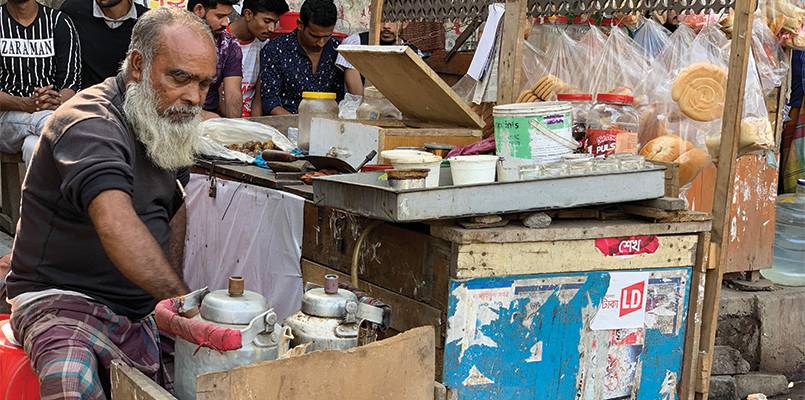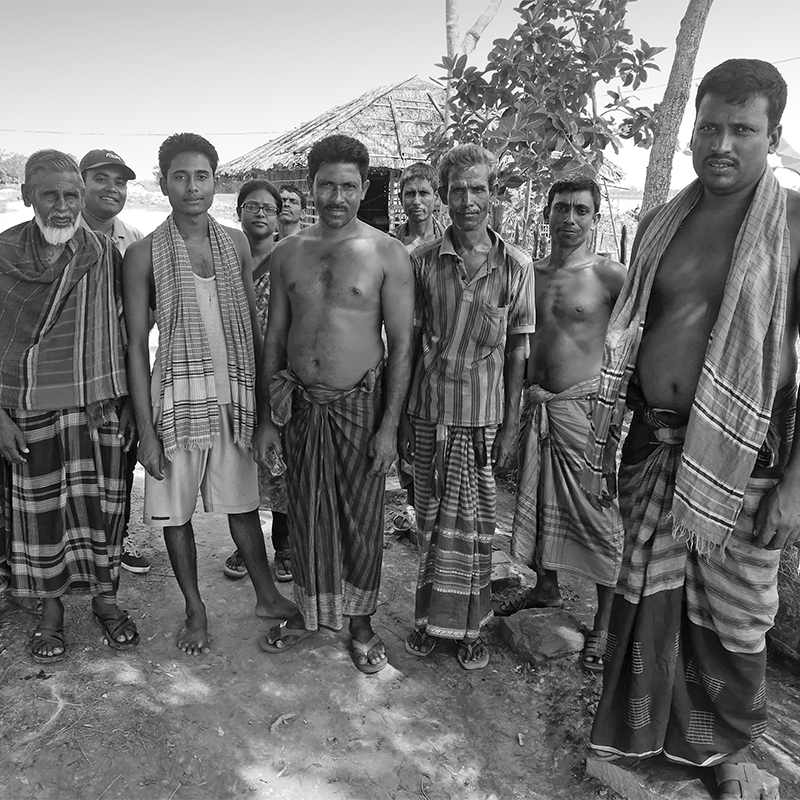Dhaka
March 12, 2020
One of the main concerns of Bangladesh, home to 170 million people, is to strengthen food security for its people. The percentage of the country’s total arable land has been decreasing since 1989. According to the Food and Agriculture Organization’s report, the country had 73 per cent arable land in 1989, which decreased to 59 per cent in 2012.
According to the Global Food Security Index, Bangladesh was ranked 83rd in 2019, the lowest among the South Asian countries. To improve the country’s position in terms of securing access to food, the government of Bangladesh has developed high-level policy initiatives, such as Vision 2021 and Perspective Plan. Such top-down tools and initiatives can only achieve their projected targets if the complex characteristics of the country’s diverse deltaic ecosystem is understood thoroughly, while acknowledging the value of ecosystem services.


TRENDS AND CHANGES IN AGRICULTURAL PRACTICES
Farming in and around Dhaka
The main driving forces for farmers in cities to become engaged in urban agriculture are food security and income generation. The urban agricultural markets are developing in response to growing demands inside the city; the demand for fruits and vegetables is increasing, which has led to the development of small farms in the city’s periphery.
A similar trend is observed in response to livestock and poultry demands inside the city. A study conducted by UNDP 1996 estimated the economic benefits of urban agriculture producers and found out that Dhaka’s urban food producers are earning $500 per person monthly from urban food production, which was much higher than the poverty line. Therefore, the expansion of urban agriculture could pull a significant portion of the urban poor out of poverty.
Agricultural land per capita has decreased by 50 per cent in the last 25 years.
They come to Dhaka and as there is no farmland in the city, they change their profession to rickshaw pullers and day labourers, small business owners, etc.
URBAN FARMING FUTURE: RECOMMENDATIONS
Curtin University of Australia, Dhaka University’s Meteorology Department and Bangladesh Institute of International and Strategic Studies (BIISS) conducted a research and found out that the average temperature of Dhaka remains at about 2 degrees Celsius higher than that of the rural areas in summer and monsoon seasons. Only 2.7 per cent of the total area in Dhaka is now protected as a green area.
References:
Al Amin, M. (2019) Demand for organic produce drives rooftop gardening, Dhaka Tribune, Available at: https://www.dhakatribune.com/bangladesh/dhaka/2019/04/27/demand-for-organic-produce-drives-rooftop-gardening, Accessed on: 1/01/2020.
BBS (2012) Statistical Year Book of Bangladesh. 2012-13, Planning Division, Ministry of Planning, Government of the People’s Republic of Bangladesh.
Bhuiyan, S. H. (2010) A crisis in governance: Urban solid waste management in Bangladesh. Habitat International 34:125–133.
BIDS (2019) Responsible food habit: Role of individual and the state, Bangladesh Institute of Development Studies.
Byomkesh, T., Nakagoshi, N. and Dewan, A.M. (2012) Urbanization and green space dynamics in Greater Dhaka, Bangladesh, Landscape and Ecological Engineering 8:45–58
Choudhury, S. (2019) Farmers’ rights over seeds: The unsung song in Bangladesh, The Daily Star, Available at: https://www.thedailystar.net/law-our-rights/news/farmers-rights-over-seeds-the-unsung-song-bangladesh-1768528, Accessed on: 2/01/2020
DAE (2016) Agricultural Extension Manual (January 2016 revision). Department of Agricultural Extension. Ministry of Agriculture. Government of the People Republic of Bangladesh, Dhaka.
Dewan, A.M. and Yamaguchi, Y. (2009) Land use and land cover change in Greater Dhaka, Bangladesh: Using remote sensing to promote sustainable urbanization, Applied Geography 29: 390–40.
Enayetullah, I.(2005) Community Based Solid Waste Management Through Public-Private-Community Partnerships: Experience of Waste Concern in Bangladesh, Waste Concern.
FAO/WHO (2003) Diet, nutrition and the prevention of chronic diseases. Report of a joint FAO/WHO. Expert Consultation. WHO Technical Report Series 916. Geneva. World Health Organization.
FAO (2014) Farmers’ Organizations in Bangladesh: A Mapping and Capacity Assessment, Food and Agricultural Organization.
Haque, S.A (2011) Potential of urban agriculture, The Daily Star, Available at: https://www.thedailystar.net/news-detail-187344, Accessed on: 7/01/2020.
Hossain A, Teixeira da Silva JA. (2013) Wheat production in Bangladesh: its future in the light of global warming, AoB PLANTS 5.
IPCC (2007) Climate Change: Impacts, Adaptation and Vulnerability. In Contribution of Working Group II to the Fourth Assessment Report of the Intergovernmental Panel on Climate Change; Cambridge University Press: Cambridge, UK.
Islam, M. S., & Ahmed, R. (2011) Land Use Change Prediction in Dhaka City Using GIS Aided. 6: 81-89. Retrieved August 28, 2015.
Lopez, E., Bocco, G., Mendoza, M., & Duhau, E. (2001). Predicting land cover and land use change in the urban fringe a case in Morelia City, Mexico. Landscape and Urban Planning 55(4): 271–285.
Mailloux, R.A. (2019) Foood Waste: a Global Problem, Dhaka Courier, Available at: https://www.dhakacourier.com.bd/news/Featured-2/food-waste-a-global-problem/1257, Accessed on: 3/01/2020.
Mamun, A., Rahman, A. and Afrooz, N. (2018) A Socio-economic Analysis of Private Plant Nursery Business in Bangladesh, The Agriculturists 16(2):102-114.
Mannaf M & Uddin MT (2012) Socioeconomic Factors Influencing Food Security Status of Maize Growing Houeholds in Selected Areas of Bogra District, Bangladesh Journal of Agricultural Economists : 177-187.
Mohajan, H.K. (2013) Food, Agriculture and Economic Situation of Bangladesh, Proceedings of 2nd International Conference on Global Sustainable Development (2nd ICGSD-2013), held on 05-06, October, 2013.
Parvez, S. (2018) Dairy industry in Bangladesh: Prospects and roadblocks, The Daily Star, Available at: https://www.thedailystar.net/supplements/dairy-industry-bangladesh-prospects-and-roadblocks-1584739, Accessed on: 29/12/2019.
Pramanik, M.A.A (2013) Prospects and Challenges of Urban and Peri-Urban Agriculture of Dhaka City, Presented at the International Conference on Agriculture, Food and Urbanizing Society, Amsterdam, Netherlands.
Quasem, M.A. (2011) Conversion of Agricultural Land to Non-agricultural Uses in Bangladesh: Extent and Determinants, The Bangladesh Development Studies, 34(1): 59-85.
Rahman, A., Nabi, A.K.M.N., Mirza, M., Rahman, H., Hossain, M., Abu Syed, M. Amin, A.M., Hossain, P.R. Mamnun, N. and Rahman, S. (2015) Building Urban Resilience: Assessing Urban and Peri-urban Agriculture in Dhaka, Bangshla. [Padgham, J. and J. Jabbour (eds.)]. United Nations Environment Programme (UNEP), Nairobi, Kenya.
Shaheen N & Islam S (2012) National Situation of Food and Nutrition Security in Bangladesh, Asian Alliance against Hunger and Malnutriton (AAHM) and the Asian NGO Coalition for Agrarian Reform and Rural Development (ANGOC).
UNDP (1996) Survey Report on Urban Agriculture of Dhaka, United Nations Development Program, Bangladesh.
UNDP (2008) Fighting Climate Change: Human Solidarity in a Divided World. Human Development Report, United Nations Development Program, Oxford University Press.
UNDP (2013) Internal Migration in Bangladesh: Character, Drivers and Policy Issues, United Nations Development Program, Bangladesh.
Wahid, S. (2016) Cultural construct of Pahela Baishakh, The Daily Star, Available at: https://www.thedailystar.net/supplements/naboborsho-1423/cultural-construct-pahela-baishakh-1208185, Accessed on: 10/01/2020.
Wardard, Y. (2014) Rooftop gardening can meet Dhaka’s 10pc of vegetable demand, Financial Express, Accessed at https://www.thefinancialexpress-bd.com/2014/11/19/66659/print , Accessed on: 10/1/2020.
World Bank (2009).Implication of Climate Change Risks on Food Security in Bangladesh. South Asia Region, June 10, 2009.
Yamashita, H. and Ishida, A. (2017) Who engages in urban and peri-urban agriculture in the condensed urban slums of Bangladesh?, Journal of Development and Agricultural Economics 9(12):373-380.
To read the complete article, get your hardcopy at our online shop/newsstands/major bookstores; subscribe to FuturArc or download the FuturArc App to read the issues.
Previously Published City Profile
Contact us at https://www.futurarc.com/contact-us for older commentaries.

